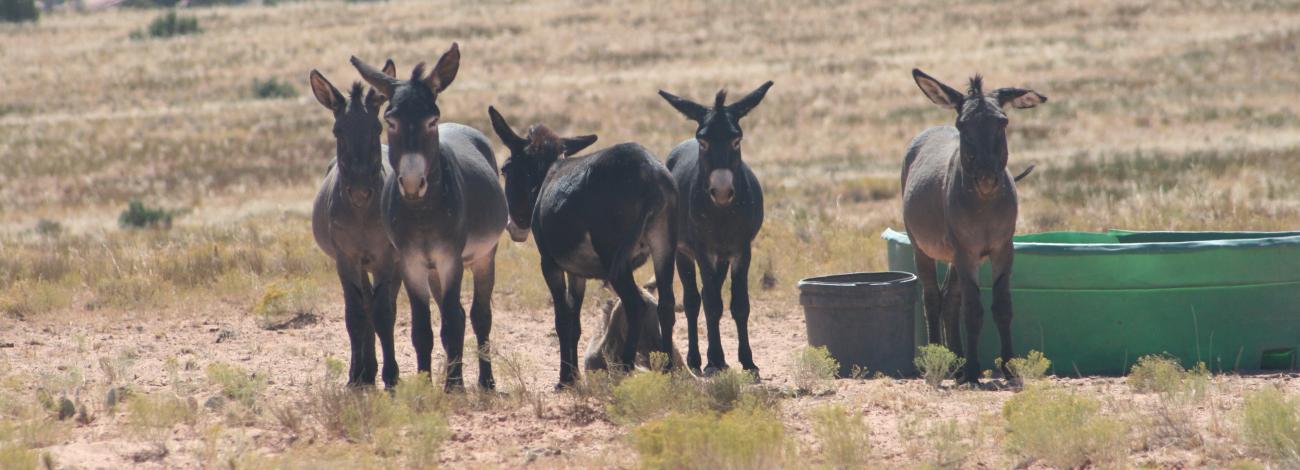
2024 Canyonlands HMA Wild Burro Gather
Purpose of Gather:
The gather decision supports the BLM’s continuing efforts to remove wild burros from within and around the Canyonlands Herd Management Area (HMA) in Wayne County to help balance the number of burros to what the rangeland can sustainably support, known as the appropriate management level (AML). The AML within the Canyonlands HMA is 60-100 animals; the current population is estimated at 151 wild burros.
Details of Gather:
Located approximately 60 miles south of Green River in Wayne County, Utah, east of Canyonlands National Park, Horseshoe Canyon and west of Glen Canyon National Recreation Area.
The HMA is comprised of 77,311 BLM acres, 10,465 State acres, and 1,616 NPS acres for a total of 89,392 acres.
The gather is expected to begin Friday, February 23, 2024 and last approximately one week.
Public Observation:
Opportunities are available for the public to observe daily gather operations through BLM-escorted tours, so long as conditions remain safe for both the burros and participants and gather operations are not disrupted. Observers must provide their own transportation, water and food. No public restrooms will be available. The BLM recommends weather-appropriate footwear and neutral-colored clothing. Binoculars and four-wheel drive or other high-clearance vehicles are also strongly recommended due to possible snowy and muddy conditions. Details about the BLM-escorted tours will be updated each evening during the gather and announced daily on the BLM gather hotline at 801-539-4050.
Adoption Information:
All excess wild horses identified for removal will be transported to the Axtell Off-Range Contract Wild Horse Facility in Axtell, Utah, where they will be checked by a veterinarian and readied for the BLM’s wild horse and burro Adoption and Sale Program. Those that are not placed into a new home will be cared for in off-range pastures, where they live off the rest of their lives on grass pastures.
For information on how to adopt or purchase a wild horse or burro, visit the Wild Horse and Burro Program page.
Background:
Originally wild burros came from the rolling desert hills and sparse vegetation of northern Africa and the Arabian Peninsula. They were utilized for their ability to be great desert pack animals- helping people carry goods across Egypt. Eventually they were domesticated in Europe and brought to North America by Christopher Columbus and others in approximately 1495.
Early prospectors relied heavily on burros as they trekked long distances across the deserts in search of gold and silver. Many of these burros survived, even though their owners perished under the harsh desert conditions. Many more burros escaped or were released during the settlement of the West. The descendent of these burros are many of the burros we see today.
Wild burros have long ears, a short mane and reach a height of up to 5 feet at the shoulders and can range in size from 400 to 500 pounds. There can be a lot of variety in their color, which can range from black, white, brown, grey and pinto; also, they can be striped, spotted or speckled.
Location
Located approximately 60 miles south of Green River in Wayne County, Utah, east of Canyonlands National Park, Horseshoe Canyon and west of Glen Canyon National Recreation Area.
Size and AML
The HMA is comprised of 77,311 BLM acres, 10,465 State acres, and 1,616 NPS acres for a total of 89,392 acres.
Topography/Vegetation
Topography is highly variable, ranging from flat desert grassland with desert shrub and rough terrain, to slightly rolling foothills carved by drainages.
Wild burros feed on a variety of plants, including grasses, Mormon tea, palo verde and plantain. Although some moisture is provided by these plant materials, wild burros must have drinking water throughout the year. They can usually be seen foraging for food during daytime, except for summers, when they will forage only at night and in the early morning.
Wild burros range through a wide variety of desert habitats as long as they are within 10 miles of drinking water and eat an average of 6,000 pounds of forage per burro per year.
Wildlife
A variety of wildlife call the HMA home, they include mule deer, coyotes, porcupines, desert cottontails, black-tailed jackrabbits, and many songbirds. A few desert animals are primarily active during the day. These include rock squirrels, antelope squirrels, chipmunks, lizards, snakes, hawks, and eagles.
Flickr Album
- Daily Gather Report - Friday, February 23, 2024
Summary: Gather has concluded.
Animals Gathered: 46
46 Wild Burros (29 Jacks, 17 Jennies, and 0 Foals)Animals Shipped: 46
46 Wild Burros (29 Jacks, 17 Jennies, and 0 Foals)Animals Treated with Fertility Control: 0 Wild Burros
Animals Released: 0 Wild Burros
Deaths: 0 Wild Burros
Gather Status
This gather began and concluded on February 23, 2024.
Animals Gathered: 46
46 Wild Burros (29 Jacks, 17 Jennies, and 0 Foals)
Animals Shipped: 46
46 Wild Burros (29 Jacks, 17 Jennies, and 0 Foals)
Animals Treated with Fertility Control: 0 Wild Burros
Animals Released: 0 Wild Burros
Deaths: 0 Wild Burros
Scroll to the bottom of this gather page for detailed “Daily Gather Reports"

